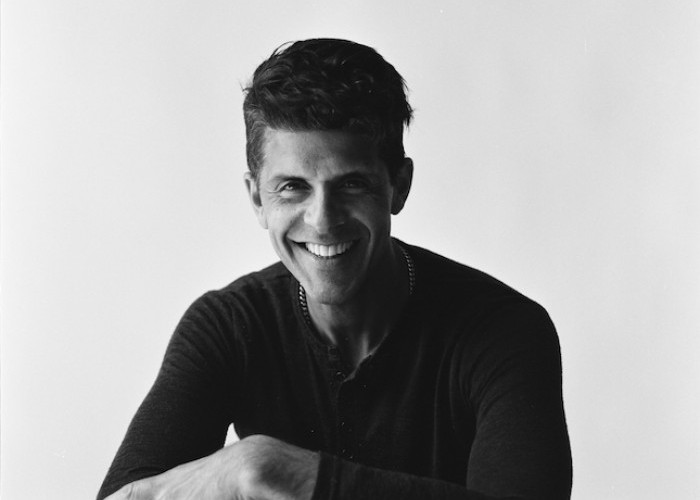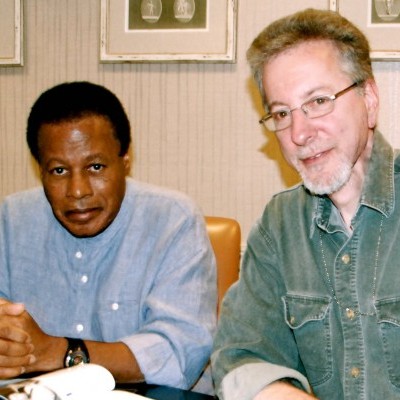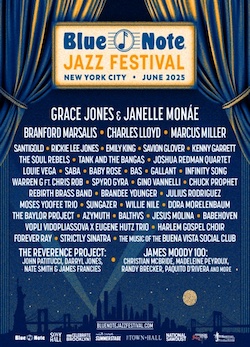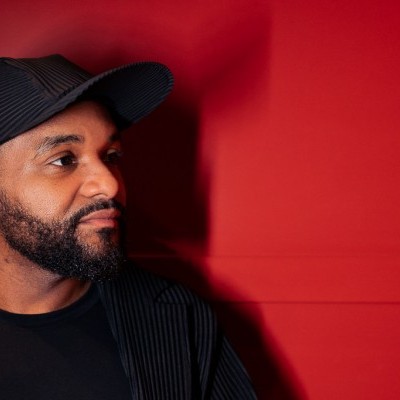Mar 4, 2025 1:29 PM
Changing of the Guard at Lincoln Center Jazz Orchestra
On October 23, Ted Nash – having toured the world playing alto, soprano and tenor saxophone, clarinet and bass…

“It’s really nice to have some kind of vision and feel like it has come to life,” says Vasandani.
(Photo: Moriah Ziman)It was just another week in the organically genre-blurry life of singer Sachal Vasandani. On a Tuesday night in February, the respected vocalist was in the spotlight with the Knoxville Jazz Orchestra, directed by John Clayton. The subject was Nat “King” Cole, whose subtle, silken vocal style is roughly in the same range and expressive palette of Vasandani’s musical voice.
Three nights later, on Valentine’s Day at New York’s storied Jazz Gallery, the singer was officially unveiling his latest album, Best Life Now. The album puts forth a seamless amalgam of pop songwriting, tight R&B grooves and jazz textures and sonorities in the mix, produced by drummer/bandleader Nate Smith in his first official production role. Vasandani’s voice occupies a smooth zone reminiscent of D’Angelo, Robert Palmer and David Sylvian, while his intelligent songwriting rises above mere pop-soul genre generics.
Other musicians — especially vocalists — might strain and feel some idiomatic whiplash in such a week’s work. But for Vasandani, such code-switching runs deep in his history as a musician.
The Chicago native studied jazz and classical music at the University of Michigan and followed a natural path to New York. There, his quickly ascending reputation found him working with Wynton Marsalis, Bobby McFerrin and many others, including Brittany Howard on the pop side of the spectrum. His discography as a leader dates back to Eyes Wide Open (Mack Avenue) in 2007 and has spanned a diverse swath of concepts and styles.
He spoke to DownBeat two days before the Valentine’s Day birth of Best Life Now.
Joe Woodard: Best Life Now is an example of the idea that you really can mix pop sensibilities, R&B and jazz — and other flavors — and get away with it. Was that an underlying concept for this project?
Sachal Vasandani: It’s just who I am at this point. I love all the music, and I really enjoyed last night in Knoxville singing with a big band. It was as straightahead as it gets, singing Nat “King” Cole with arrangements by John Clayton. I don’t get sick of that.
But there’s another voice, especially when I’m writing, that I just need to be honest with. It certainly has all the other elements. I’m conscious of that — not so much when I’m writing it, but when it comes out. It’s part of my own journey. I’ve always been writing and always been listening and trying to go deep and broad. With this (album), I was just trying to make it personal. It’s almost like the genre comes as an afterthought.
Woodard: Did you go into this project with sort of a conceptual guideline for what it would be? Or, did it sort of materialize as you went along?
Vasandani: More of the former. I took a long time to write the music and a long time to collaborate with Nate on putting it all together. We had a couple days in the studio, which was enough because we had done the prep, and then I took a long time after the studio to retrack and think about things and bring my team into it, mixing engineers and tracking engineers and guest artists.
It has been a long process. As a musician, there’s always more that we can do, and more that we can collaborate on. But it’s really nice to have some kind of vision and feel like it has come to life.
Woodard: This album is very different, for instance, from the previous two albums, Midnight Shelter and Still Life, involving cover songs with just you and piano.
Vasandani: That’s right. And there was a reason for that. The last two records I did were recorded during the height of the pandemic.
And in both selection and instrumentation, and even the color of my voice, I was thinking about melancholy and all the darkness that pretty much everybody else was feeling. I wanted to capture that because I also had been feeling that.
And then for this new one, I wanted to have something that feels more celebratory.
Woodard: Can we qualify the album as a dance record?
Vasandani: Yes, sir. After you’ve been in your little apartment for two years in a pandemic somewhere in the world, it’s time to get out and dance. That’s really what it was.
Woodard: But it does contain a melancholic strain to some of the lyrics, with different angles on love and lost love. It’s not just party music.
Vasandani: That’s right. I certainly was feeling I wanted to put everything to a beat, and that was coming out of the pandemic. But it doesn’t mean that the troubles or the things that I’m feeling are resolved and super happy. [laughs] Even if there were some themes that we want to wrestle with, [there was an attitude of] “let’s do it with a tapping of our toes,” letting the band play and letting people like Nate bring the heat.
Woodard: Nate Smith is such a strong and versatile drummer, and his band Kinfolk also moves in various directions. How did the creative process work with him in producer mode?
Vasandani: He’s outstanding as a musician and as a collaborator. And if you saw Kinfolk, then you know that he’s got his own vision, and it’s dope. He has been in the thick of it for a minute there, crafting ideas, crafting strategies, writing melodies, writing lyrics. He’s a real deal. Yes.
He co-wrote a song with Michael Jackson [“Heaven Can Wait,” from the 2001 album Invincible] well before he was a famous drummer. He can play the piano, and he can help me reharmonize things. He has an ear for melody.
But I think the takeaway is that I really count him as a generous and solid human being, and I need that in my life. You’re putting out there something [through the lyrics], and the songs are not entirely just my experience. They’re not grotesquely autobiographical, [laughs] but there’s a lot that’s rooted in my experience.
Woodard: Your tune “Call Me” shifts from a pretty simple chord structure in main body of the song, the beginning, but then exploding into a more complicated coda section solo by saxophonist Dayna Stephens.
Vasandani: You’re right. I kind of wanted to make it like an earworm and then surprise folks with a different kind of energy, but always popping.
Woodard: You have said that D’Angelo was one inspiration for this set of songs.
Vasandani: For sure. The sexiness, the simplicity and the focus on space.
Woodard: The title track, “Best Life Now,” is almost a motto for living. Is there a story behind that song?
Vasandani: That is kind of autobiographical. I’m trying to work out married life and fatherhood with a smile on my face. It’s not all coming together the way maybe I envisioned it. There are these jagged metal pieces and ways that I’m dealing with it. Maybe they’re not always good for me or good for the people around me, but honestly writing the song has helped me a lot.
So many artists are great role models now, but I think when I was coming up, I was working through my own artistic journey and maybe was not great at relationships. I’ve evolved and part of that evolution is being honest, like with what I’m struggling with. Moving past it is part of what that song is about.
Woodard: You do a beautiful duet with Gretchen Parlato. Do you view her as a model of a “jazz” vocalist that you fit in with, that of being stylistically elastic?
Vasandani: Yeah, exactly. [laughs] I like that word elastic. And that is true, but before I documented it within my records, Gretchen was always doing that, that which felt natural to her. Tierney Sutton was a big influence on us both. At that time, she was like a real mentor to Gretchen in particular because they’re both L.A. people.
But I really enjoyed getting to know Tierney at that time. Tierney’s got her own sound, too, but I think her aesthetic up until that point had been pretty straightahead, for lack of a better word.
Even at that time, Gretchen was saying, “That’s not exactly how I’m thinking about performing this stuff.” On my first records, even though I did originals and covers of pop songs, I did them in a very kind of acoustic, straight-ahead way. It kind of took me until 2009 to start to experiment with different sounds, different flavors, different textures, and I guess I’ve been doing that as a through line ever since.
I’ve really come to this idea, to bring us back to what you were saying earlier: It’s just gotta be true to me. And if you want to tie it into Gretchen, that was true to Gretchen all those years ago. That’s all we can really ask for as artists, that we connect with ourselves, give the best versions of ourselves, and then let it go out into the world.
Woodard: When your life as a singer began, did you have a vision of what you wanted to do? Or did that shift?
Vasandani: I was always writing songs off the side, but my North Stars were really the most swinging stuff I could find. That could have been some of the work I did with the Lincoln Center Jazz Orchestra or other people that were in that milieu — Rodney Whitaker, John Clayton, Jeff Hamilton, Bill Charlap. These were kind of my go-to people as a performer and also as a listener, but not exclusively listening to that.
These other things started to seep in. But as a performer, I wanted to take whatever I was listening to and put it into that acoustic, largely swinging setting. It was fun and cool, but I started to feel there were different ways that I can get this music across that makes sense.
Woodard: You have a fresh version of “What’s New” on the new album, contrasting the intimate voice-piano jazz arrangement of the pop tune “I Can’t Make You Love Me” on your Still Life album. That’s an interesting paradox.
Vasandani: For me, it’s like finding the truth and the honesty and what I can relate to in a given moment, with any song. If I happen to write it, great. Sometimes there are great songs out there. That was a case with a pop song like “I Can’t Make You Love Me,” which I’ve been listening to since whenever it came out. I was just enamored with it. It’s a great, well-written song. I wish I wrote it, [laughs] and I love singing it. There are some songs that I love to listen to, but don’t really feel like I have a perspective on it. But the flip side of that is the honest awesome things that I do have to say, I can say them in any genre.
When I find a connection with the song, whether it’s “What’s New” or “Straighten Up And Fly Right” or something like Bonnie Raitt — and I have a perspective to offer — I’m gonna sing it.
Woodard: How did this spin on “What’s New” come to be? Was it just kind of a light-bulb moment?
Vasandani: That actually was a light-bulb moment. That was the one tune that we kind of worked on as a group in the studio. I had the idea for letting it be really spare. But then the vamp at the end was Nate — he hooked it up. We all kind of sat around at the piano and tried out a few things for like 10 minutes. Then, when we recorded it, I could sense right away that it was gonna be this wonderful vehicle for Dayna.
The record is tight, it’s pocket-based, and on “What’s New” and “Call Me” there’s some stretching in a couple places. But mostly it’s just about the songs. It’s very singer-focused in that way, but those singers don’t need to be pop. That’s how the old jazz singers approached the Great American Songbook, Rodgers and Hart stuff, and they didn’t have blazing solos. But now when I’m doing it live, I’m finding it fun and compelling to open it up, open up with the guys, and just have fun with it.
Woodard: You might be engaged in some musical evangelism work here. Listeners who maybe aren’t familiar with the breadth of what you’ve done might be lured in and then hear “What’s New” and be hipped to the tune, as happened when Linda Ronstadt did it with Nelson Riddle. Do you like that idea?
Vasandani: This is my hope. My background is jazz. I’m a jazz singer. I’m being interviewed by a jazz magazine. It’s all who I am. It’s all who we are. But my hope is that this music can reach out to anybody, anybody who wants to tap their feet.
It’s got to start with my jazz community, my people. But I’d be thrilled if the lyrics touched people — because oftentimes lyrics come a little bit later in the priority of jazz people. I know that from experience, and that’s not good or bad. But out there in the listening public, folks do like lyrics. My hope is that folks will vibe on that from a lyrical perspective.
Woodard: Just looking at the trajectory of your career, is this moment almost a new chapter that you’re embarking on?
Vasandani: I would definitely say so. It’s been a minute since my last record, and something’s brewing. DB

As Ted Nash, left, departs the alto saxophone chair for LCJO, Alexa Tarantino steps in as the band’s first female full-time member.
Mar 4, 2025 1:29 PM
On October 23, Ted Nash – having toured the world playing alto, soprano and tenor saxophone, clarinet and bass…

Larry Appelbaum with Wayne Shorter in 2012.
Feb 25, 2025 10:49 AM
Larry Appelbaum, a distinguished audio engineer, jazz journalist, historian and broadcaster, died Feb. 21, 2025, in…

“This is one of the great gifts that Coltrane gave us — he gave us a key to the cosmos in this recording,” says John McLaughlin.
Mar 18, 2025 3:00 PM
In his original liner notes to A Love Supreme, John Coltrane wrote: “Yes, it is true — ‘seek and ye shall…

The Blue Note Jazz Festival New York kicks off May 27 with a James Moody 100th Birthday Celebration at Sony Hall.
Apr 8, 2025 1:23 PM
Blue Note Entertainment Group has unveiled the lineup for the 14th annual Blue Note Jazz Festival New York, featuring…

“You’ve got to trust that inner child, keep exploring, even though people think it’s wrong,” says Fortner.
Feb 25, 2025 11:20 AM
Every week at the Village Vanguard fosters its own sound. No one really knows how the music might evolve by Sunday, but…